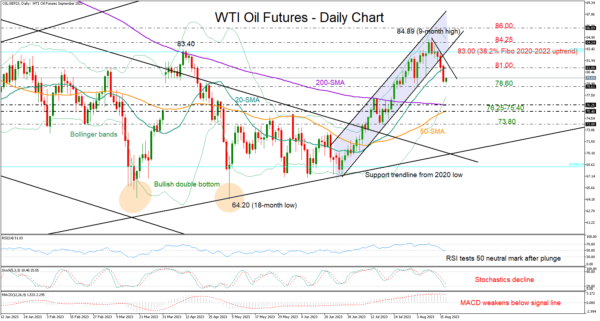WTI oil futures got hammered after the peak at a nine-month high of 84.89, breaking out of the tight bearish channel that had been navigating the market over the past two months.
The price has re-entered the broad neutral area below 83.40, closing significantly below the 20-day simple moving average (SMA) and the 80.00 round level on Wednesday. The latter is a negative warning that the sell-off could gain extra impetus and the technical indicators are in line with this narrative. The MACD is decelerating below its red signal line, while the RSI is set to cross below its 50 neutral mark. Meanwhile, the stochastic oscillator hasn’t bottomed out yet, and the price itself is still above the lower Bollinger band, meaning sellers may still be in control for a while.
Should the bears snap the nearby floor of 78.60 too, the price could next seek shelter somewhere between the 200- and 50-day SMAs at 76.25 and 75.40 respectively. A step lower could halt near the 73.80 constraining zone, where the price rotated northwards in mid-July.
In the event of an upside reversal, traders will look for a close above the 20-day SMA at 81.00 before they target again the former resistance of 83.00-83.40. Then, an extension above last week’s bar of 84.25 could lift the price up to 86.00 last seen during August-November 2022.
Encouragingly, the 50-day SMA has reduced its gap with the 200-day SMA. Hence, it would be interesting to see if the lines will manage to post a bullish cross in the weeks ahead. If a bullish cross were to happen, the latest upleg could regain some trust.
Summing up, the short-term bias has switched back to bearish in the WTI crude market, with selling pressures expected to intensify again below 78.60.














